Intelligent Sensors and Environment Driven Biological Comfort Control Based Smart Energy Consumption System
Abstract
:1. Introduction
- To capture the human behavior and responses to the environmental change impact, a CBD response capturing model is developed and analyzed. The model used CBD parameters, such as: (a) Vasodilation, (b) Vasoconstriction, (c) Convection, (d) Conduction, (e) Radiation, (f) Respiration, and (g) Metabolism rate that determine the present state of consumer thermal CL.
- We develop a comprehensive EMS model incorporating the effects of different EPs, and the real-time data of the surrounding environment. The effects of outdoor environmental fluctuations on indoor parameters are also elaborated mathematically with this proposed model. Building parameters are measured based on sensor data and integrated with EMS.
- To build a stable EMS, we developed a closed-loop control system to control the impact of EPs variations on the CBD. Three different EPs inputs, such as extreme cold, hot persisting, and normal conditions are used to test the designed feedback control system (classical PID and Adaptive Neuro-Fuzzy-Type II). The performance of both controllers is also tested and compared.
- Under the EMS model, six different cases for consumer EC are simulated that describe EC reductions and EC cost reductions with PID and NF-II controllers. Moreover, the performance of our proposed model is verified experimentally by developing a smart IoT-based hardware setup using parameters of the winter season as a test case. The IoT board (ESP826) is connected to the Azure IoT Hub platform from Microsoft via the MQTT protocol is used.
2. Literature Review
3. Preliminary Study of the Parameters and Models Used in the System Model
3.1. Environmental Parameters (EPs)
3.2. Thermal Building Model
3.3. Consumer Body Dynamics
3.3.1. Heat Balance Equations 69-MN Model
3.3.2. Heat Capacity of Nodes C (a,b)
3.3.3. Heat Production Q (a,b)
3.3.4. Rate of Heat Transfer by Blood Stream B (a,b)
3.3.5. Heat Transfer by Conduction D (a,b)
3.4. Intrinsic EP Effects on Consumer Body Comfort
4. Modelling, Analysis, and Design of Comfort-Based Smart Energy Management System
4.1. Objective Function
4.2. Adaptive Neuro-Fuzzy Type II Controller Used to Control EMS
4.3. Structure of Neuro-Fuzzy Type II Controller
5. Performance Evaluations
5.1. Simulation Settings
5.2. Parameters of Thermal House
5.2.1. Consumer Data
5.2.2. Maximum and Minimum Environmental Data
5.3. Energy Consumption (EC) Cases
5.3.1. Case 1: Normal Operation without Consumer Body Comfort
5.3.2. Case 2: Set-Point Device Switching
5.3.3. Case 3: Comfort Based Control Incorporating CBD
5.3.4. Case 4: Extreme Cold Outdoor Environment
5.3.5. Case 5: Hot Persisting Conditions
5.3.6. Case 6: Normal Environmental Conditions
5.4. Experimental Work
5.5. Threats to Validity
5.5.1. Internal Validity
5.5.2. External Validity
5.5.3. Construct Validity
6. Conclusions and Future Work
Author Contributions
Funding
Acknowledgments
Conflicts of Interest
Abbreviations
| Acronym | Definition | Acronym | Definition |
| AT | Air Temperature | EMS | Energy Management System |
| AV | Air Velocity | IoT | Internet-of-Things |
| AP | Air Pressure | MN | Multi-Node |
| CL | Comfort Level | NF-II | Neuro-Fuzzy-Type II |
| CBD | Consumer Body Dynamics | PCS | Personal Comfort System |
| DT | Dew Point Temperature | PID | Proportional Integral Derivative |
| EC | Energy Consumption | RT | Radiant Temperature |
| EPs | Environmental Parameter | RH | Relative Humidity |
| c | Specific heat capacity of air | Pa | Air Pressure |
| Cf | comfort level | ρ | Air density |
| Va | Air Velocity | BF (a,b) | Blood flow rate |
| V | Volume of the room | Tskin | Skin Temperature |
References
- Shaukat, N.; Ali, S.M.; Mehmood, C.A.; Khan, B.; Jawad, M.; Farid, U.; Ullah, Z.; Anwar, S.M.; Majid, M. A survey on consumers empowerment, communication technologies, and renewable generation penetration within Smart Grid. Renew. Sustain. Energy Rev. 2018, 81, 1453–1475. [Google Scholar] [CrossRef]
- Energy Information Administration. 2018. Available online: http://www.eia.doe.gov (accessed on 10 January 2021).
- Aslam, S.; Herodotou, H.; Mohsin, S.M.; Javaid, N.; Ashraf, N.; Aslam, S. A survey on deep learning methods for power load and renewable energy forecasting in smart microgrids. Renew. Sustain. Energy Rev. 2021, 144, 110992. [Google Scholar] [CrossRef]
- Deka, K.; Bhanja, D.; Nath, S. Fundamental solution of steady and transient bio heat transfer equations especially for skin burn and hyperthermia treatments. Heat Transf. Asian Res. 2019, 48, 361–378. [Google Scholar] [CrossRef]
- Li, K.; Su, H.; Chu, J. Forecasting building energy consumption using neural networks and hybrid neuro-fuzzy system: A comparative study. Energy Build. 2011, 43, 2893–2899. [Google Scholar] [CrossRef]
- Ashouri, M.; Haghighat, F.; Fung, B.C.; Lazrak, A.; Yoshino, H. Development of building energy saving advisory: A data mining approach. Energy Build. 2018, 172, 139–151. [Google Scholar] [CrossRef]
- Koelblen, B.; Psikuta, A.; Bogdan, A.; Annaheim, S.; Rossi, R.M. Thermal sensation models: Validation and sensitivity towards thermo-physiological parameters. Build. Environ. 2018, 130, 200–211. [Google Scholar] [CrossRef]
- ASHRAE. Chapter 9 Thermal Comfort, Handbook Fundamentals; American Society of Heating, Refrigeration and Air Conditioning Engineers: Atlanta, GA, USA, 2017; pp. 19–20. Available online: http://courses.washington.edu/me333afe/ASHRAE_Comfort.pdf (accessed on 1 June 2022).
- Luo, M.; Cao, B.; Ji, W.; Ouyang, Q.; Lin, B.; Zhu, Y. The underlying linkage between personal control and thermal comfort: Psychological or physical effects? Energy Build. 2016, 111, 56–63. [Google Scholar] [CrossRef]
- Ali, S.M.; Khan, B.; Mokryani, G.; Mehmood, C.A.; Jawad, M.; Farid, U. Environment driven consumer EC model incorporating complexities of consumer body dynamics. IET Energy Syst. Integr. 2019, 1, 53–64. [Google Scholar] [CrossRef]
- Wang, Z.; Nazaripouya, H.; Ali, S.M.; Mokryani, G.; Khan, B.; Mehmood, C.A.; Jawad, M.; Alizadeh-Mousavi, O.; Jaton, J. Smart Energy System for Human Body Control, IEEE eNewsletter Smart Grid Applications and Enhancements 2019. Available online: https://smartgrid.ieee.org/bulletins/february-2019/smart-energy-system-for-human-body-control (accessed on 20 August 2020).
- Ghani, S.; Bialy, E.M.; Bakochristou, F.; Gamaledin, S.M.A.; Rashwan, M.M.; Hughes, B. Thermal comfort investigation of an outdoor air-conditioned area in a hot and arid environment. Sci. Technol. Built Environ. 2017, 23, 1113–1131. [Google Scholar] [CrossRef] [Green Version]
- Mishra, A.K.; Loomans, M.G.L.C.; Hensen, J.L. Thermal comfort of heterogeneous and dynamic indoor conditions—An overview. Build. Environ. 2016, 109, 82–100. [Google Scholar] [CrossRef] [Green Version]
- Poel, B.; van Cruchten, G.; Balaras, C.A. Energy performance assessment of existing dwellings. Energy Build. 2007, 39, 393–403. [Google Scholar] [CrossRef]
- Rupp, R.F.; Kim, J.; de Dear, R.; Ghisi, E. Associations of occupant demographics, thermal history and obesity variables with their thermal comfort in air-conditioned and mixed-mode ventilation office buildings. Build. Environ. 2018, 135, 1–9. [Google Scholar] [CrossRef]
- Santamouris, M.; Cartalis, C.; Synnefa, A.; Kolokotsa, D. On the impact of urban heat island and global warming on the power demand and electricity consumption of buildings—A review. Energy Build. 2015, 98, 119–124. [Google Scholar] [CrossRef]
- Wang, H.; Chen, Q. Impact of climate change heating and cooling energy use in buildings in the United States. Energy Build. 2014, 82, 428–436. [Google Scholar] [CrossRef] [Green Version]
- Mao, N.; Pan, D.; Li, Z.; Xu, Y.; Song, M.; Deng, S. A numerical study on influences of building envelope heat gain on operating performances of a bed-based task/ambient air conditioning (TAC) system in energy saving and thermal comfort. Appl. Energy 2017, 192, 213–221. [Google Scholar] [CrossRef]
- Berger, T.; Amann, C.; Formayer, H.; Korjenic, A.; Pospischal, B.; Neururer, C.; Smutny, R. Impacts of climate change upon cooling and heating energy demand of office buildings in Vienna, Austria. Energy Build. 2014, 80, 517–530. [Google Scholar] [CrossRef]
- Tanabe, S.I.; Kobayashi, K.; Nakano, J.; Ozeki, Y.; Konishi, M. Evaluation of thermal comfort using combined multi-node thermoregulation (65MN) and radiation models and computational fluid dynamics (CFD). Energy Build. 2002, 34, 637–646. [Google Scholar] [CrossRef] [Green Version]
- Ouédraogo, E.; Coulibaly, O.; Imbga, K.B.; Koala, O.A.G.; Ouédraogo, A.; Kieno, F.P.; Bathiebo, D.J. Designing an Energy-Efficient Building in a Context of Helping Self-Build. Am. J. Energy Eng. 2018, 6, 29. [Google Scholar] [CrossRef]
- Luo, M.; Arens, E.; Zhang, H.; Ghahramani, A.; Wang, Z. Thermal comfort evaluated for combinations of energy-efficient personal heating and cooling devices. Build. Environ. 2018, 143, 206–216. [Google Scholar] [CrossRef] [Green Version]
- Shahzad, S.; Calautit, K.; Wei, S.; Tien, P.W.; Calautit, J.; Hughes, B. Analysis of the thermal comfort and energy performance of a thermal chair for Open Plan Office. J. Sustain. Dev. Energy Water Environ. Syst. 2020, 8, 373–395. [Google Scholar] [CrossRef]
- Song, W.; Zhang, Z.; Chen, Z.; Wang, F.; Yang, B. Thermal comfort and energy performance of Personal Comfort Systems (PCS): A systematic review and meta-analysis. Energy Build. 2022, 256, 111747. [Google Scholar] [CrossRef]
- Li, D.; Menassa, C.C.; Kamat, V.R. Personalized human comfort in indoor building environments under diverse conditioning modes. Build. Environ. 2017, 126, 304–317. [Google Scholar] [CrossRef]
- Cruz Rios, F.; Naganathan, H.; Chong, W.K.; Lee, S.; Alves, A. Analyzing the impact of outside temperature on energy consumption and production patterns in high-performance research buildings in Arizona. J. Archit. Eng. 2017, 23, C4017002-1. [Google Scholar] [CrossRef]
- Taleghani, M. Outdoor thermal comfort by different heat mitigation strategies—A Review. Renew. Sustain. Energy Rev. 2018, 81, 2011–2018. [Google Scholar] [CrossRef]
- Wang, Y.; Kuckelkorn, J.; Zhao, F.-Y.; Spliethoff, H.; Lang, W. A state of art of review on interactions between energy performance and indoor environment quality in Passive House Buildings. Renew. Sustain. Energy Rev. 2017, 72, 1303–1319. [Google Scholar] [CrossRef]
- Holma, A.; Leskinen, P.; Myllyviita, T.; Manninen, K.; Sokka, L.; Sinkko, T.; Pasanen, K. Environmental impacts and risks of the National Renewable Energy Targets—A review and a qualitative case study from Finland. Renew. Sustain. Energy Rev. 2018, 82, 1433–1441. [Google Scholar] [CrossRef]
- Kalvelage, K.; Passe, U.; Rabideau, S.; Takle, E.S. Changing climate: The effects on energy demand and human comfort. Energy Build. 2014, 76, 373–380. [Google Scholar] [CrossRef]
- Pablo-Romero, M.D.P.; Sánchez-Braza, A.; González-Jara, D. Economic growth and global warming effects on electricity consumption in Spain: A sectoral study. Environ. Sci. Pollut. Res. 2022, 1–17. [Google Scholar] [CrossRef]
- Geography and Wind—Lowa Energy Center. 2018. Available online: http://www.iowaenergycenter.org/wind-energy-manual/wind-and-wind-power/geography-and-wind (accessed on 15 October 2018).
- Kobayashi, Y.; Tanabe, S.I. Development of JOS-2 human thermoregulation model with detailed vascular system. Build. Environ. 2013, 66, 1–10. [Google Scholar] [CrossRef]
- Solis-Cisneros, H.I.; Sevilla-Camacho, P.Y.; Robles-Ocampo, J.B.; Zuñiga-Reyes, M.A.; Rodríguez-Resendíz, J.; Muñiz-Soria, J.; Hernández-Gutiérrez, C.A. A dynamic reconfiguration method based on neuro-fuzzy control algorithm for partially shaded PV arrays. Sustain. Energy Technol. Assess. 2022, 52, 102147. [Google Scholar] [CrossRef]
- Farid, U.; Khan, B.; Ullah, Z.; Ali, S.M.; Mehmood, C.A.; Farid, S.; Sajjad, R.; Sami, I.; Shah, A. Control and identification of dynamic plants using adaptive neuro-fuzzy type-2 strategy. In Proceedings of the 2017 International Conference on Energy Conservation and Efficiency (ICECE), Lahore, Pakistan, 22–23 November 2017. [Google Scholar]
- Torres-Salinas, H.; Rodríguez-Reséndiz, J.; Cruz-Miguel, E.E.; Ángeles-Hurtado, L.A. Fuzzy logic and genetic-based algorithm for a servo control system. Micromachines 2022, 13, 586. [Google Scholar] [CrossRef] [PubMed]
- Ensastiga, S.A.; Rodríguez-Reséndiz, J.; Estévez-Bén, A.A. Speed controller-based fuzzy logic for a biosignal-feedbacked cycloergometer. Comput. Methods Biomech. Biomed. Eng. 2021, 25, 750–763. [Google Scholar] [CrossRef] [PubMed]
- Macias-Bobadilla, G.; Becerra-Ruiz, J.D.; Estévez-Bén, A.A.; Rodríguez-Reséndiz, J. Fuzzy Control-based system feed-back by OBD-II data acquisition for complementary injection of hydrogen into internal combustion engines. Int. J. Hydrogen Energy 2020, 45, 26604–26612. [Google Scholar] [CrossRef]
- García-Martínez, J.R.; Cruz-Miguel, E.E.; Carrillo-Serrano, R.V.; Mendoza-Mondragón, F.; Toledano-Ayala, M.; Rodríguez-Reséndiz, J. A PID-type Fuzzy Logic Controller-based approach for motion control applications. Sensors 2020, 20, 5323. [Google Scholar] [CrossRef] [PubMed]
- Zeb, K.; Uddin, W.; Islam, S.U.; Khan, I.; Ishfaq, M.; Ullah, Z.; Haider, A.; Kim, H.J. Adaptive Fuzzy Logic Controller for indirect field oriented controlled induction motor. In Proceedings of the 2019 2nd International Conference on Computing, Mathematics and Engineering Technologies (iCoMET), Sukkur, Pakistan, 30–31 January 2019. [Google Scholar]
- Griefahn, B.; Künemund, C.; Gehring, U. The significance of air velocity and turbulence intensity for responses to horizontal drafts in a constant air temperature of 23 C. Int. J. Ind. Ergon. 2000, 26, 639–649. [Google Scholar] [CrossRef]
- Soyguder, S. Intelligent system based on wavelet decomposition and neural network for predicting of fan speed for energy saving in HVAC system. Energy Build. 2011, 43, 814–822. [Google Scholar] [CrossRef]
- Mendel, J.M. Uncertain Rule-Based Fuzzy Logic System: Introduction and New Directions; Prentice Hall: Upper Saddle River, NJ, USA, 2001. [Google Scholar]
- Biglarbegian, M.; Melek, W.W.; Mendel, J.M. On the stability of interval type-2 TSK fuzzy logic control systems. IEEE Trans. Syst. Man Cybern. Part B (Cybern.) 2010, 40, 798–818. [Google Scholar] [CrossRef]
- Historical Average Weather. Available online: https://www.worldweatheronline.com (accessed on 20 October 2019).
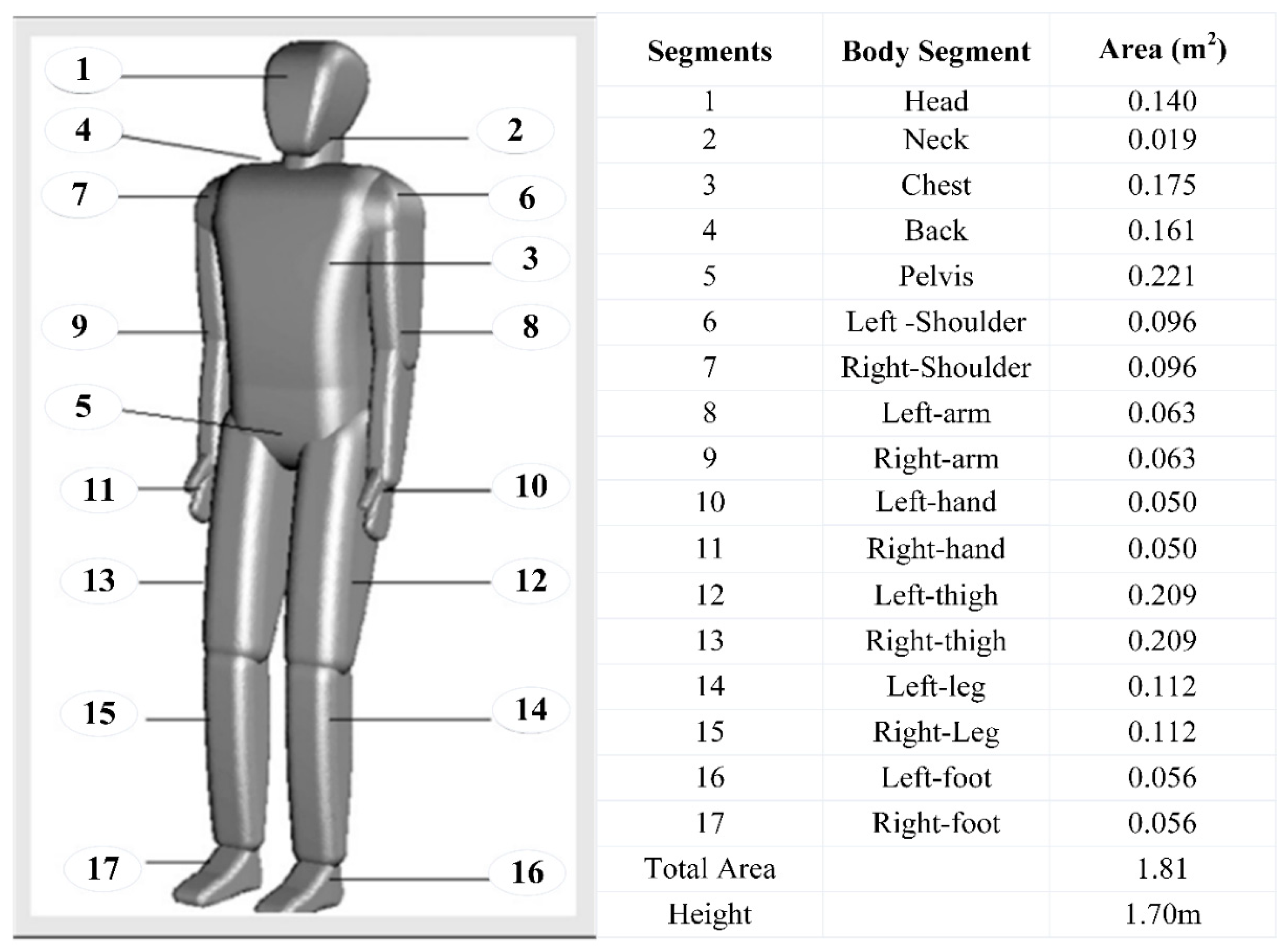

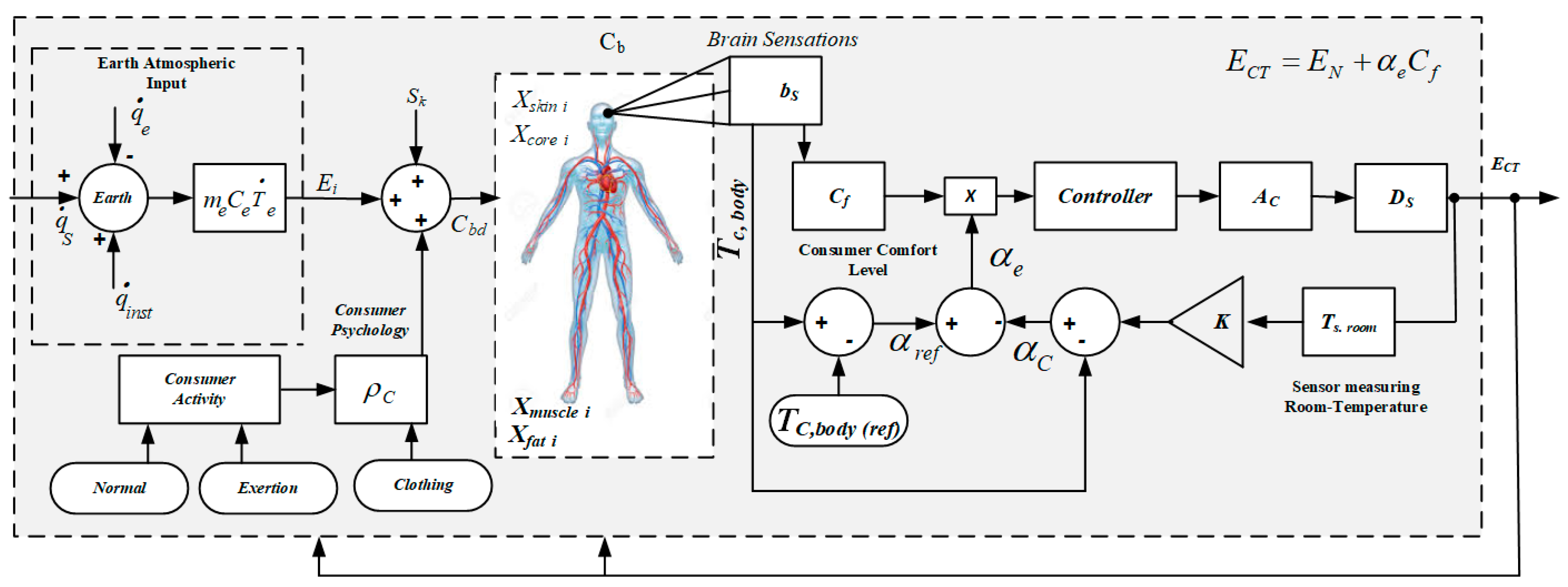

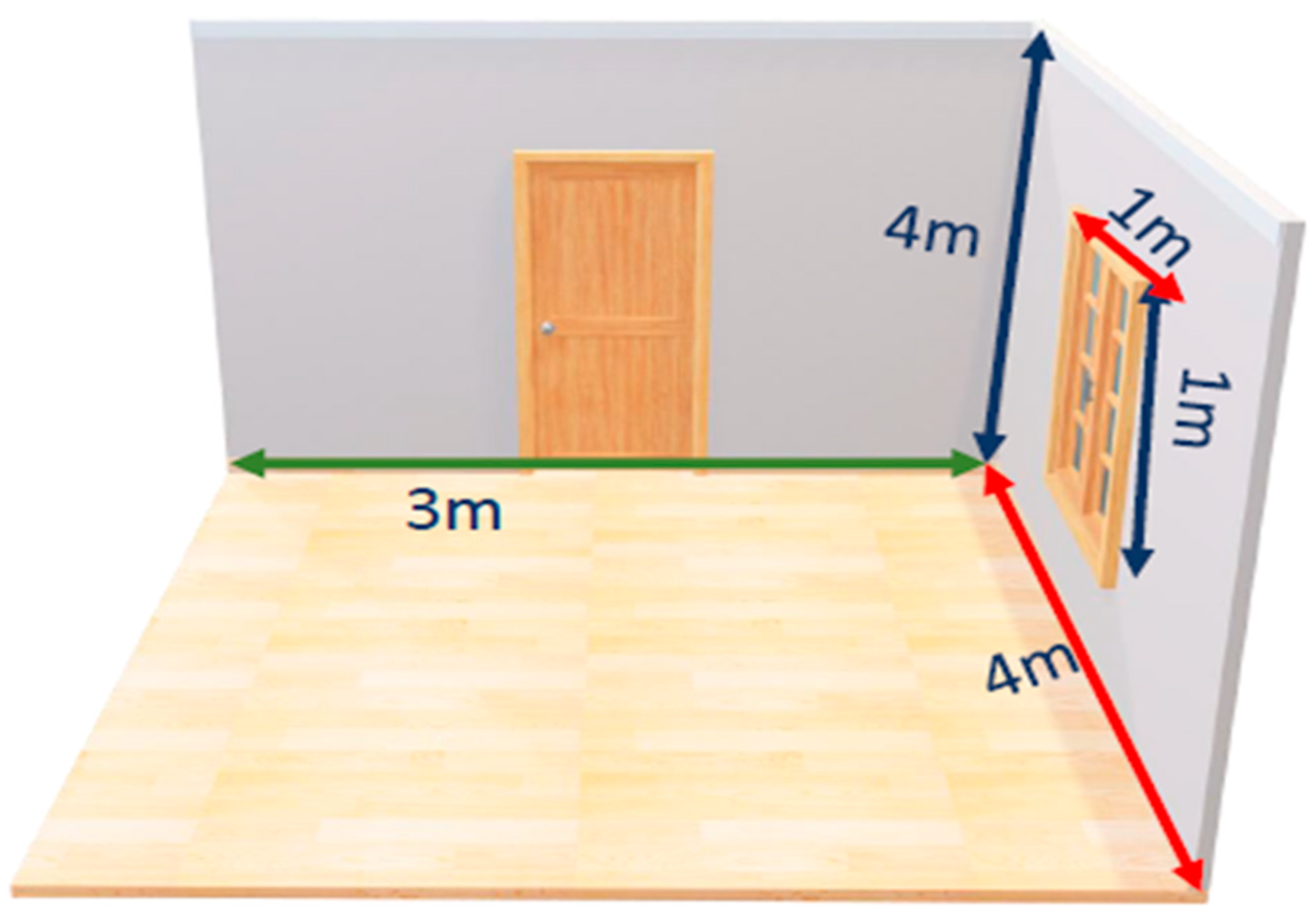

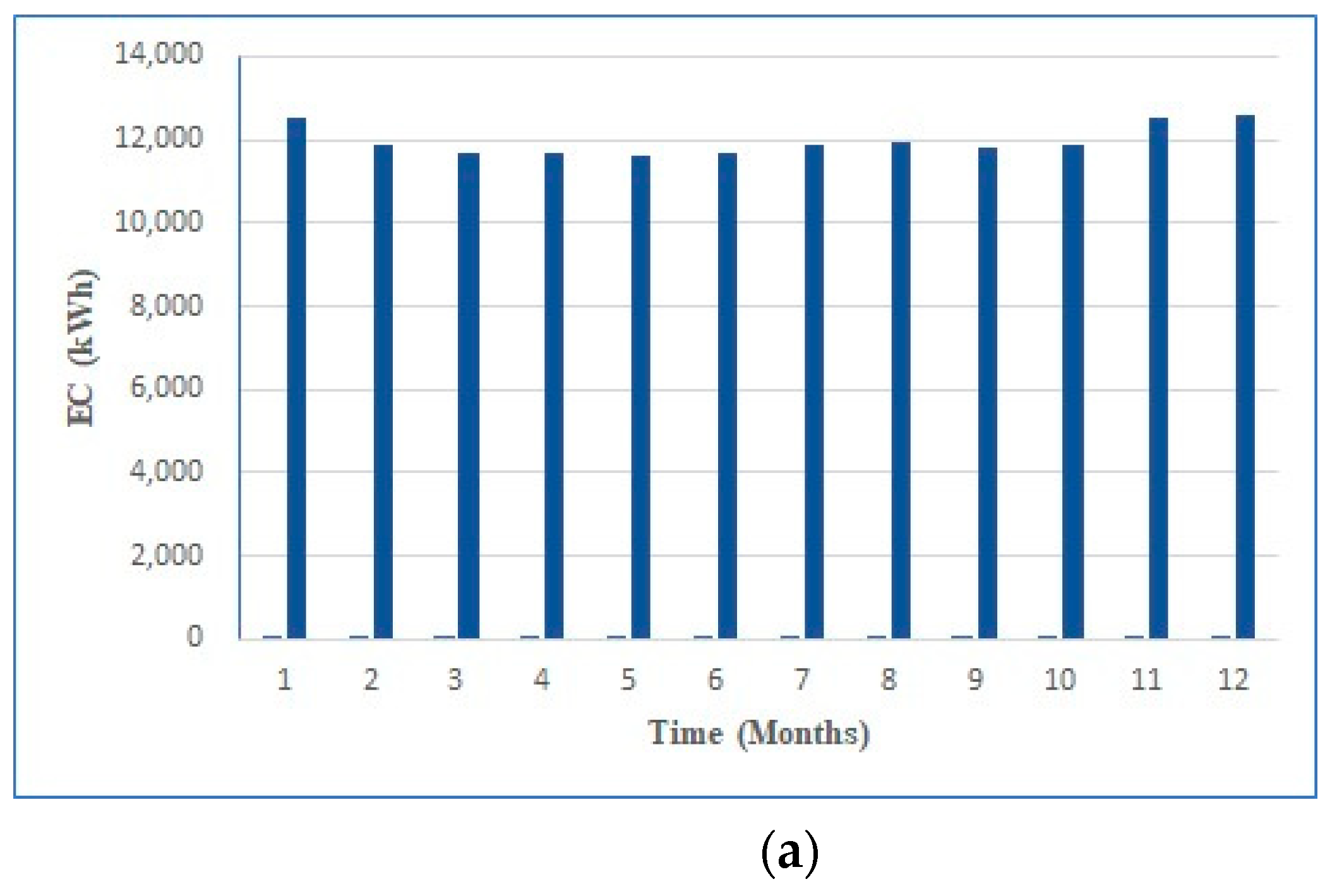
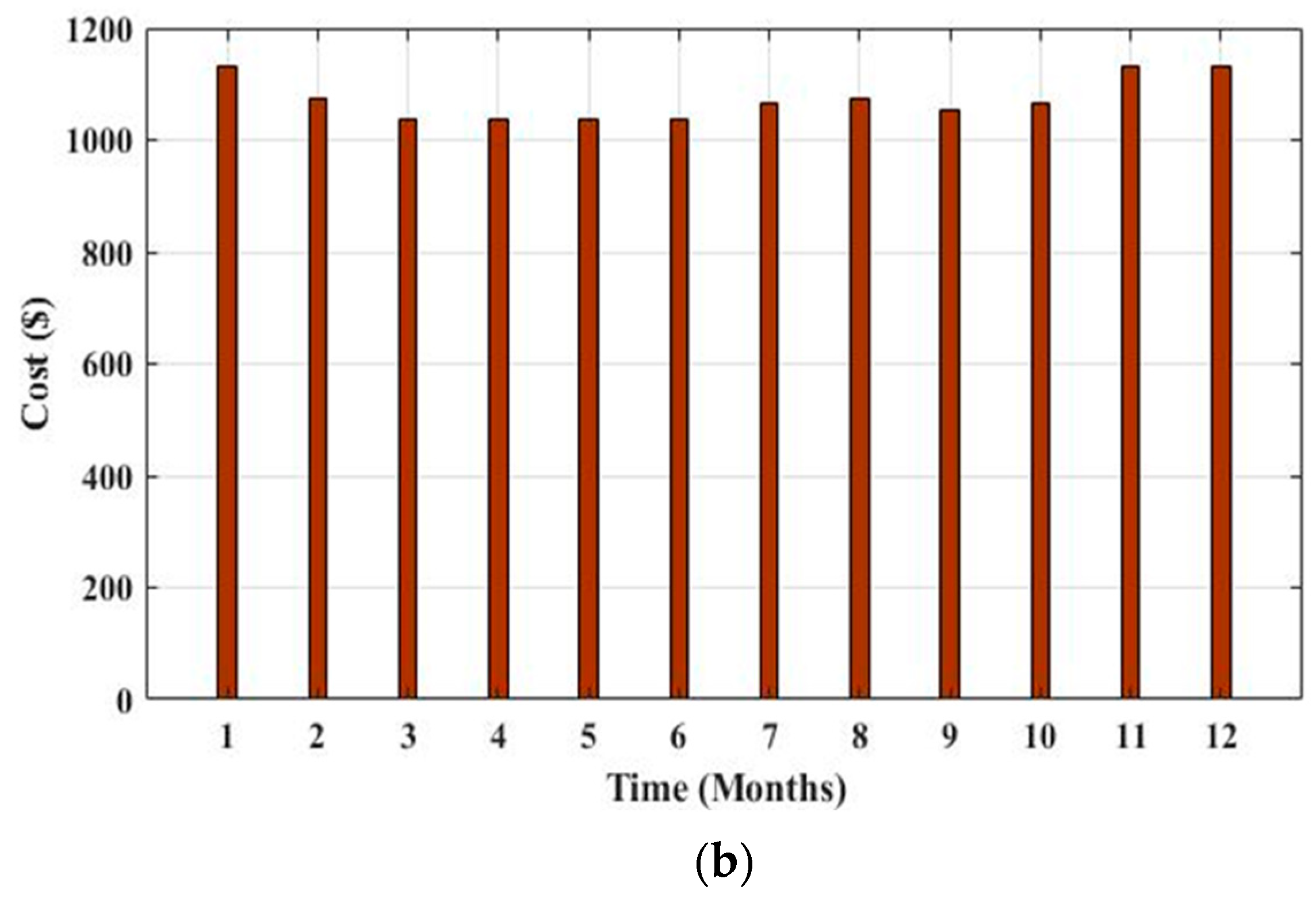

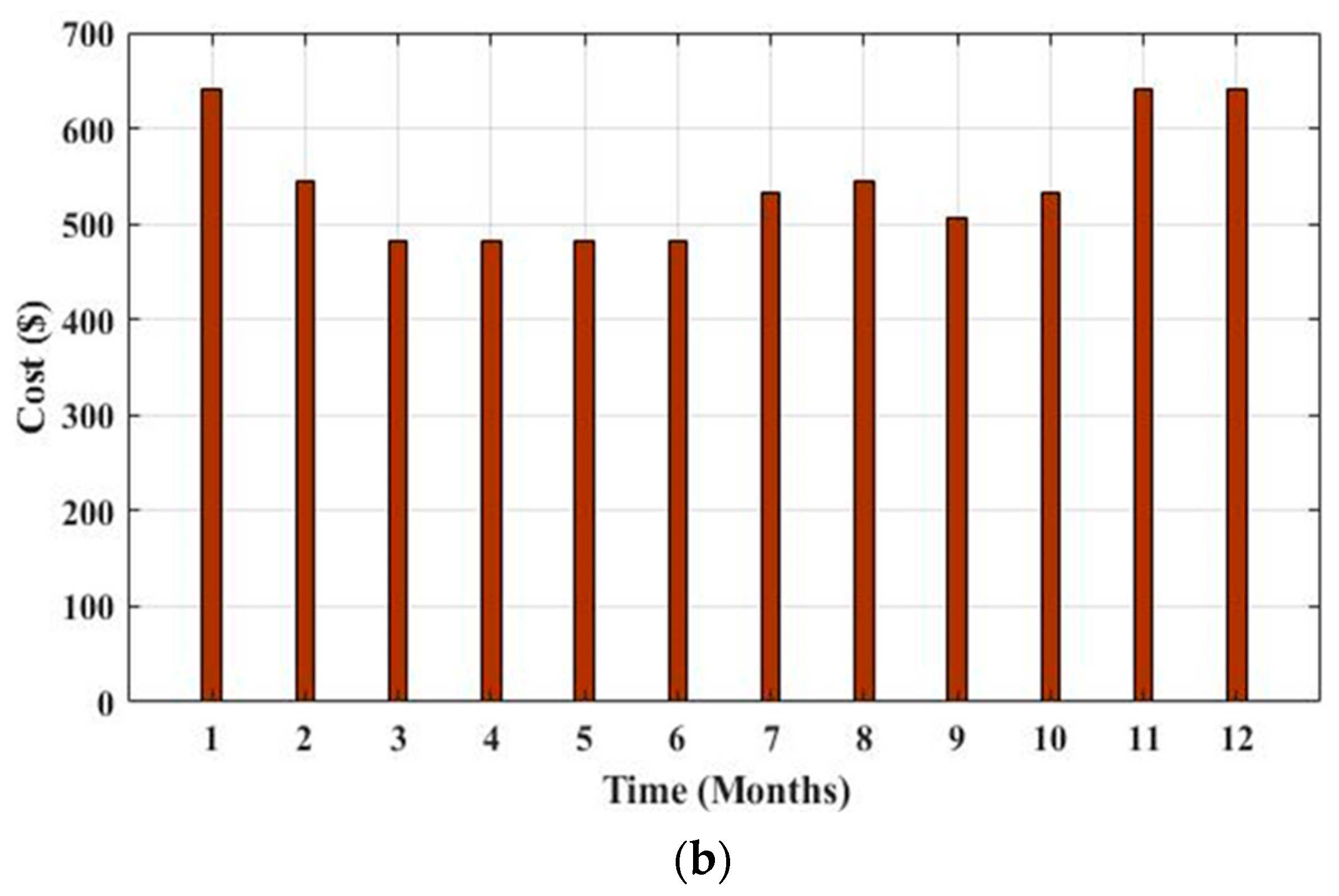
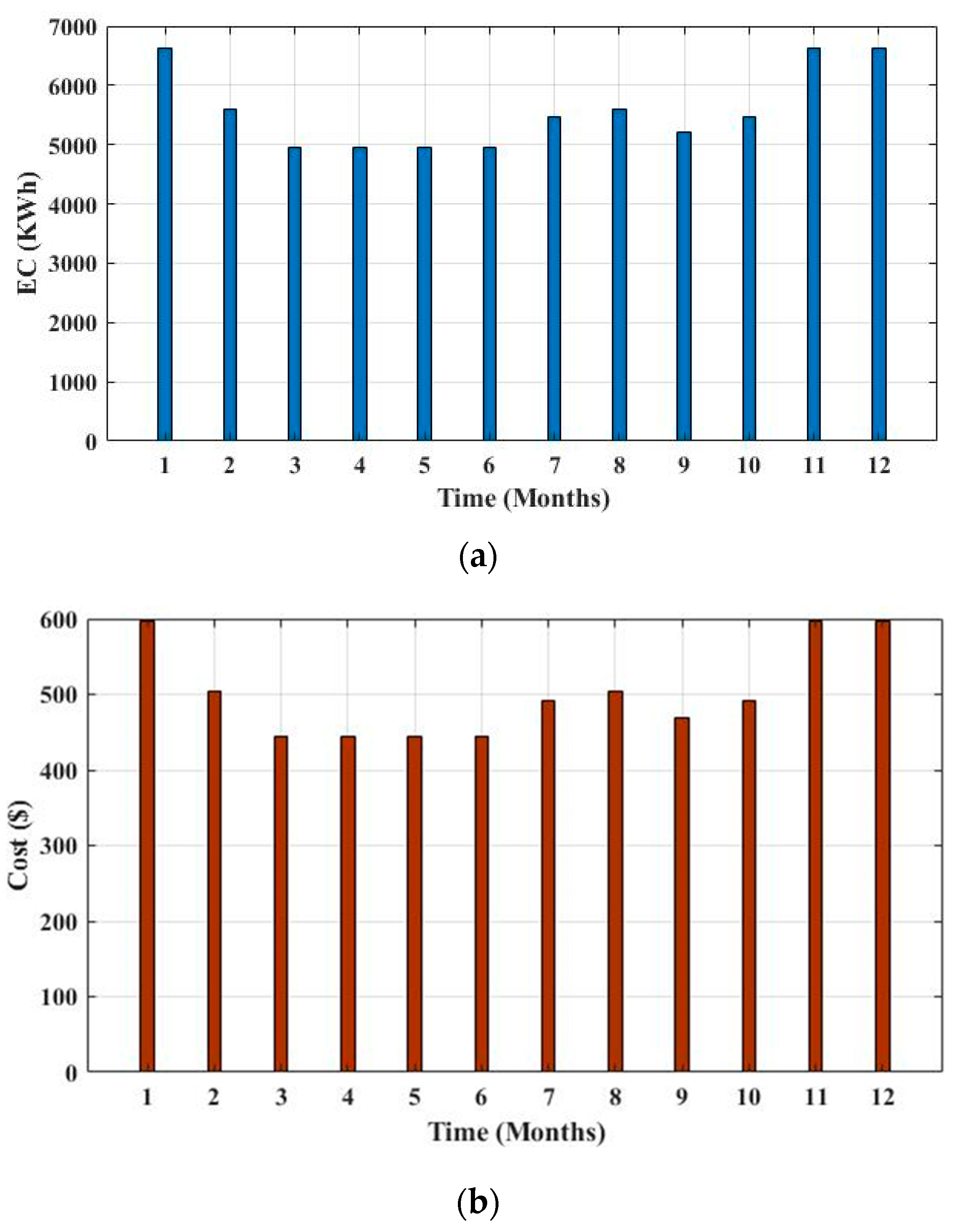
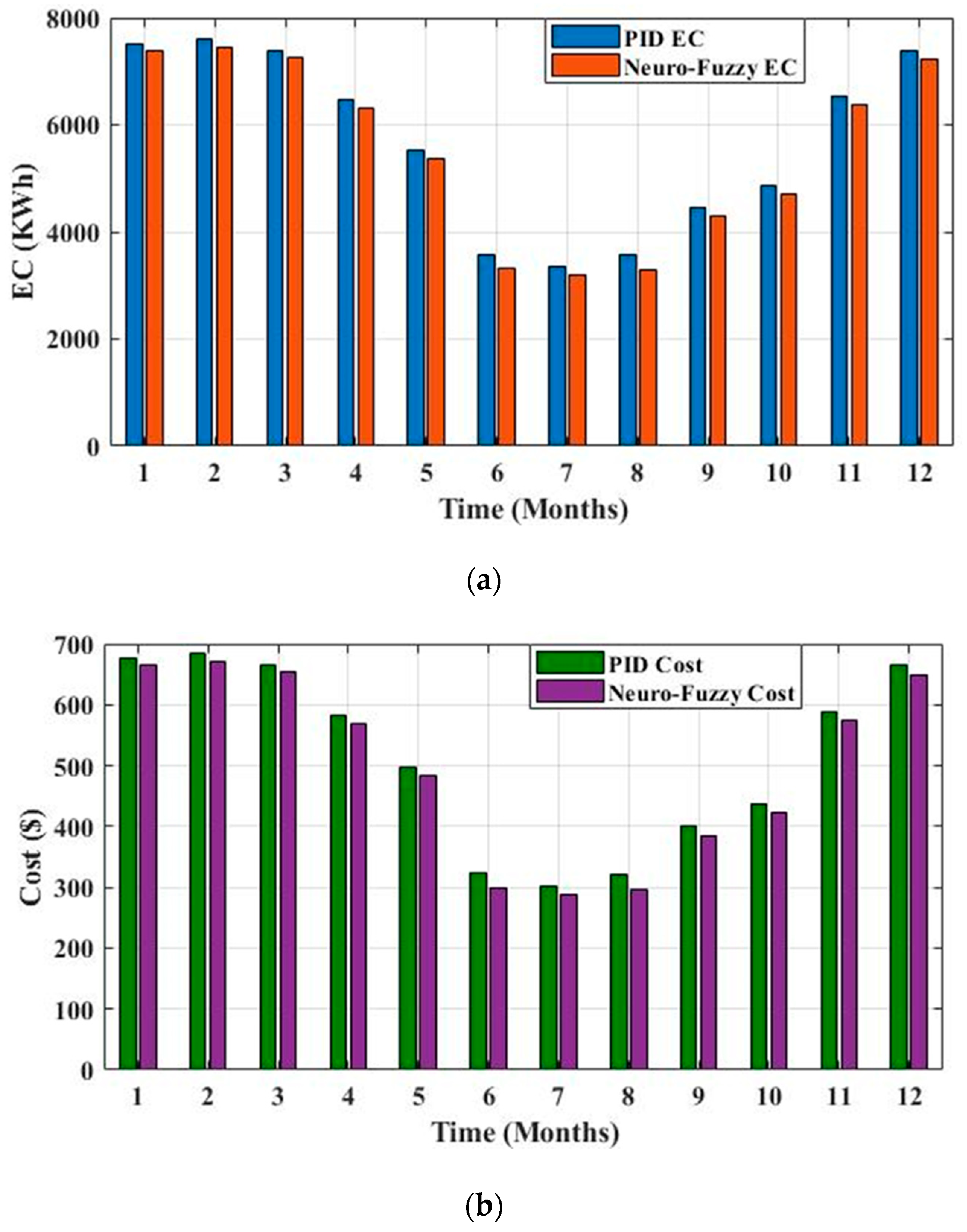

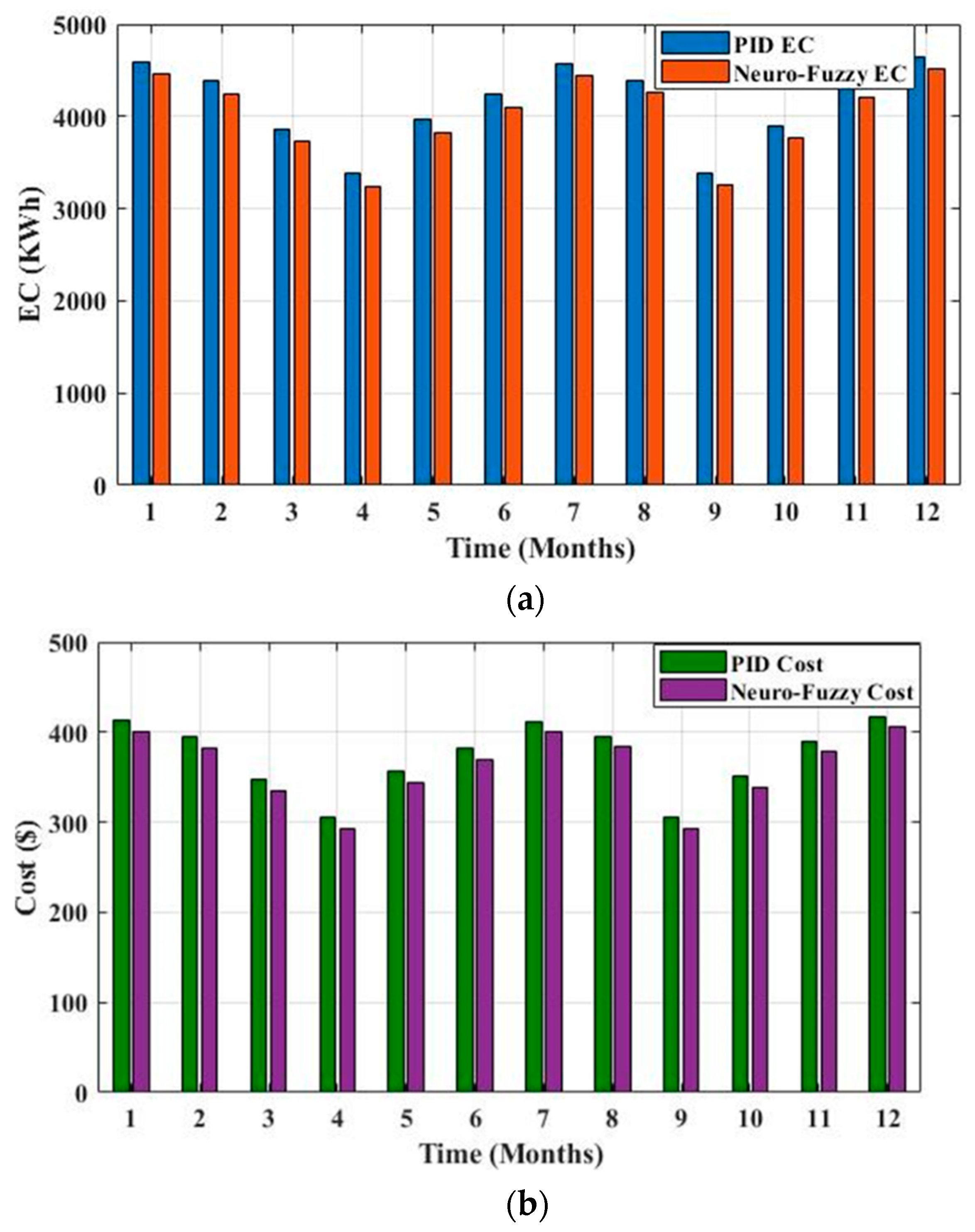
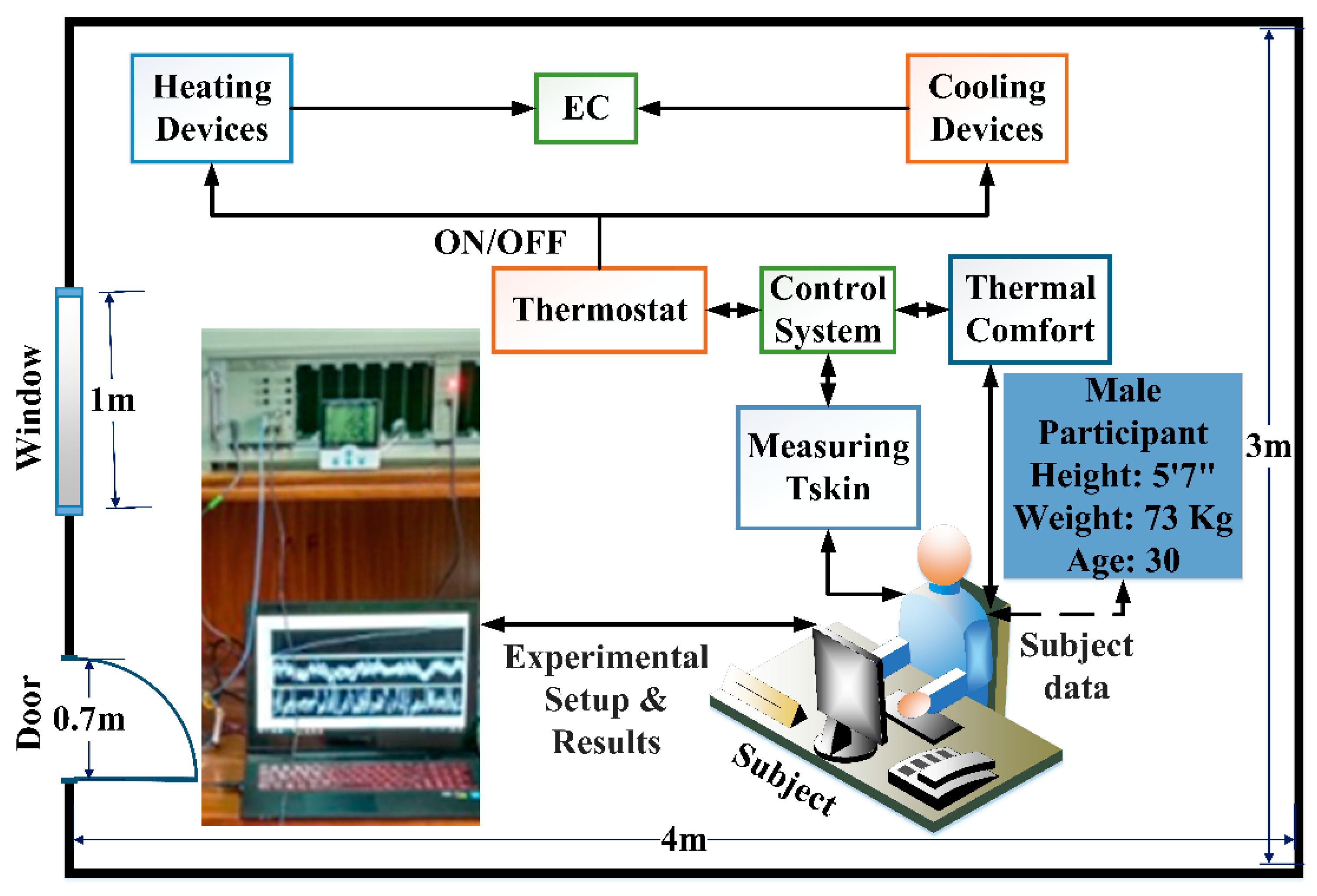

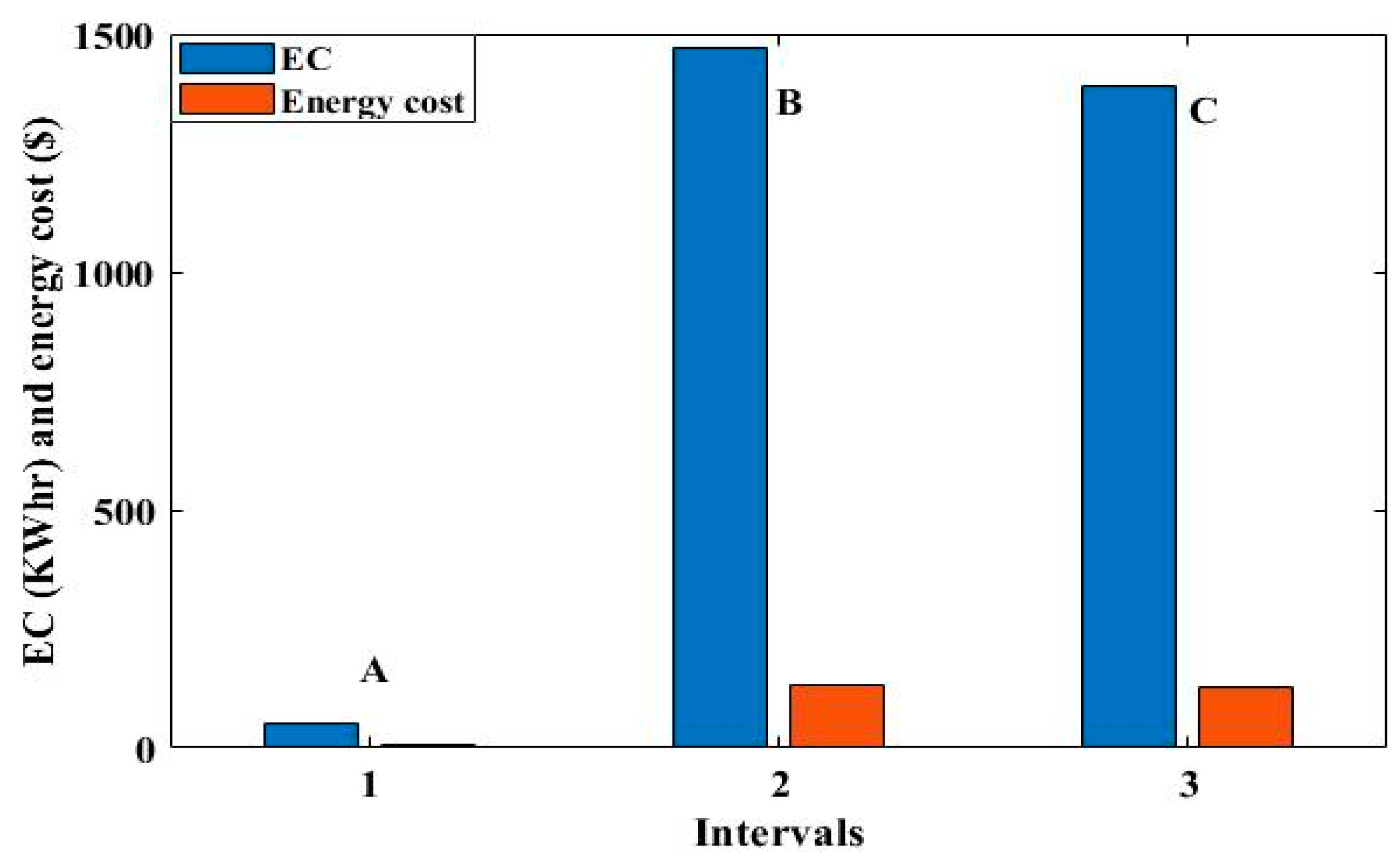
| Ref. | EC | EMM | EV | ED | HBIE | HMM | COP | CIEC | CIP | CCHC | HEEC |
|---|---|---|---|---|---|---|---|---|---|---|---|
| [12] | ✕ | 🗸 | ✕ | ✕ | 🗸 | 🗸 | ✕ | ✕ | ✕ | 🗸 | ✕ |
| [13] | 🗸 | ✕ | 🗸 | 🗸 | 🗸 | 🗸 | ✕ | 🗸 | 🗸 | 🗸 | ✕ |
| [14] | 🗸 | ✕ | ✕ | 🗸 | ✕ | ✕ | ✕ | 🗸 | 🗸 | 🗸 | ✕ |
| [15] | ✕ | ✕ | 🗸 | ✕ | 🗸 | 🗸 | 🗸 | ✕ | 🗸 | 🗸 | 🗸 |
| [16] | ✕ | ✕ | ✕ | ✕ | 🗸 | ✕ | ✕ | ✕ | ✕ | 🗸 | ✕ |
| [17] | 🗸 | ✕ | ✕ | ✕ | ✕ | ✕ | ✕ | ✕ | 🗸 | ✕ | ✕ |
| [18] | ✕ | 🗸 | 🗸 | ✕ | ✕ | ✕ | ✕ | ✕ | ✕ | ✕ | ✕ |
| [19] | ✕ | ✕ | 🗸 | 🗸 | ✕ | ✕ | 🗸 | 🗸 | 🗸 | ✕ | ✕ |
| [20] | ✕ | 🗸 | ✕ | ✕ | 🗸 | 🗸 | 🗸 | ✕ | 🗸 | 🗸 | 🗸 |
| [21] | 🗸 | ✕ | ✕ | ✕ | 🗸 | ✕ | 🗸 | 🗸 | 🗸 | 🗸 | ✕ |
| [22] | 🗸 | ✕ | 🗸 | ✕ | 🗸 | ✕ | ✕ | 🗸 | 🗸 | 🗸 | 🗸 |
| [23] | ✕ | ✕ | 🗸 | ✕ | ✕ | ✕ | 🗸 | 🗸 | ✕ | ✕ | ✕ |
| [24] | 🗸 | ✕ | 🗸 | ✕ | 🗸 | ✕ | ✕ | ✕ | 🗸 | 🗸 | 🗸 |
| [25] | 🗸 | ✕ | 🗸 | ✕ | ✕ | ✕ | 🗸 | ✕ | 🗸 | 🗸 | ✕ |
| [26] | 🗸 | ✕ | ✕ | 🗸 | ✕ | ✕ | 🗸 | 🗸 | ✕ | ✕ | 🗸 |
| [27] | ✕ | ✕ | ✕ | ✕ | ✕ | ✕ | 🗸 | ✕ | ✕ | 🗸 | ✕ |
| [28] | ✕ | ✕ | 🗸 | ✕ | 🗸 | ✕ | ✕ | ✕ | ✕ | ✕ | ✕ |
| [29] | ✕ | ✕ | 🗸 | ✕ | 🗸 | 🗸 | ✕ | ✕ | ✕ | ✕ | ✕ |
| [30] | ✕ | ✕ | 🗸 | ✕ | 🗸 | ✕ | ✕ | ✕ | 🗸 | 🗸 | ✕ |
| This work | 🗸 | 🗸 | 🗸 | 🗸 | 🗸 | 🗸 | 🗸 | 🗸 | 🗸 | 🗸 | 🗸 |
| Ref. | Research Focus | Data Analysis | Findings |
|---|---|---|---|
| [26] | Effects of outdoor climatic parameters on buildings’ energy consumption and production |
|
|
| [27] | Human CL and COP |
|
|
| [31] | Temperature effects on power demand of a firm |
|
|
| Energy Consumptions (kWh) | ||||||||||||
|---|---|---|---|---|---|---|---|---|---|---|---|---|
| Controller | Hours | |||||||||||
| 1 | 2 | 3 | 4 | 5 | 6 | 7 | 8 | 9 | 10 | 11 | 12 | |
| PID | 5320 | 5980 | 6100 | 6250 | 6250 | 6500 | 6000 | 6000 | 6150 | 5840 | 5270 | 5320 |
| Neuro-Fuzzy Type II | 5550 | 6180 | 6500 | 6550 | 6550 | 6800 | 6400 | 6300 | 6650 | 6300 | 5500 | 5550 |
| Cost ($) | ||||||||||||
| Controller | Hours | |||||||||||
| 1 | 2 | 3 | 4 | 5 | 6 | 7 | 8 | 9 | 10 | 11 | 12 | |
| PID | 520 | 550 | 570 | 585 | 610 | 610 | 570 | 570 | 585 | 550 | 480 | 520 |
| Neuro-Fuzzy Type II | 570 | 600 | 610 | 615 | 640 | 640 | 610 | 610 | 565 | 600 | 530 | 570 |
Publisher’s Note: MDPI stays neutral with regard to jurisdictional claims in published maps and institutional affiliations. |
© 2022 by the authors. Licensee MDPI, Basel, Switzerland. This article is an open access article distributed under the terms and conditions of the Creative Commons Attribution (CC BY) license (https://creativecommons.org/licenses/by/4.0/).
Share and Cite
Nawaz, M.A.; Khan, B.; Ali, S.M.; Awais, M.; Qureshi, M.B.; Jawad, M.; Mehmood, C.A.; Ullah, Z.; Aslam, S. Intelligent Sensors and Environment Driven Biological Comfort Control Based Smart Energy Consumption System. Electronics 2022, 11, 2622. https://doi.org/10.3390/electronics11162622
Nawaz MA, Khan B, Ali SM, Awais M, Qureshi MB, Jawad M, Mehmood CA, Ullah Z, Aslam S. Intelligent Sensors and Environment Driven Biological Comfort Control Based Smart Energy Consumption System. Electronics. 2022; 11(16):2622. https://doi.org/10.3390/electronics11162622
Chicago/Turabian StyleNawaz, Muhammad Asim, Bilal Khan, Sahibzada Muhammad Ali, Muhammad Awais, Muhammad Bilal Qureshi, Muhammad Jawad, Chaudhry Arshad Mehmood, Zahid Ullah, and Sheraz Aslam. 2022. "Intelligent Sensors and Environment Driven Biological Comfort Control Based Smart Energy Consumption System" Electronics 11, no. 16: 2622. https://doi.org/10.3390/electronics11162622
APA StyleNawaz, M. A., Khan, B., Ali, S. M., Awais, M., Qureshi, M. B., Jawad, M., Mehmood, C. A., Ullah, Z., & Aslam, S. (2022). Intelligent Sensors and Environment Driven Biological Comfort Control Based Smart Energy Consumption System. Electronics, 11(16), 2622. https://doi.org/10.3390/electronics11162622










